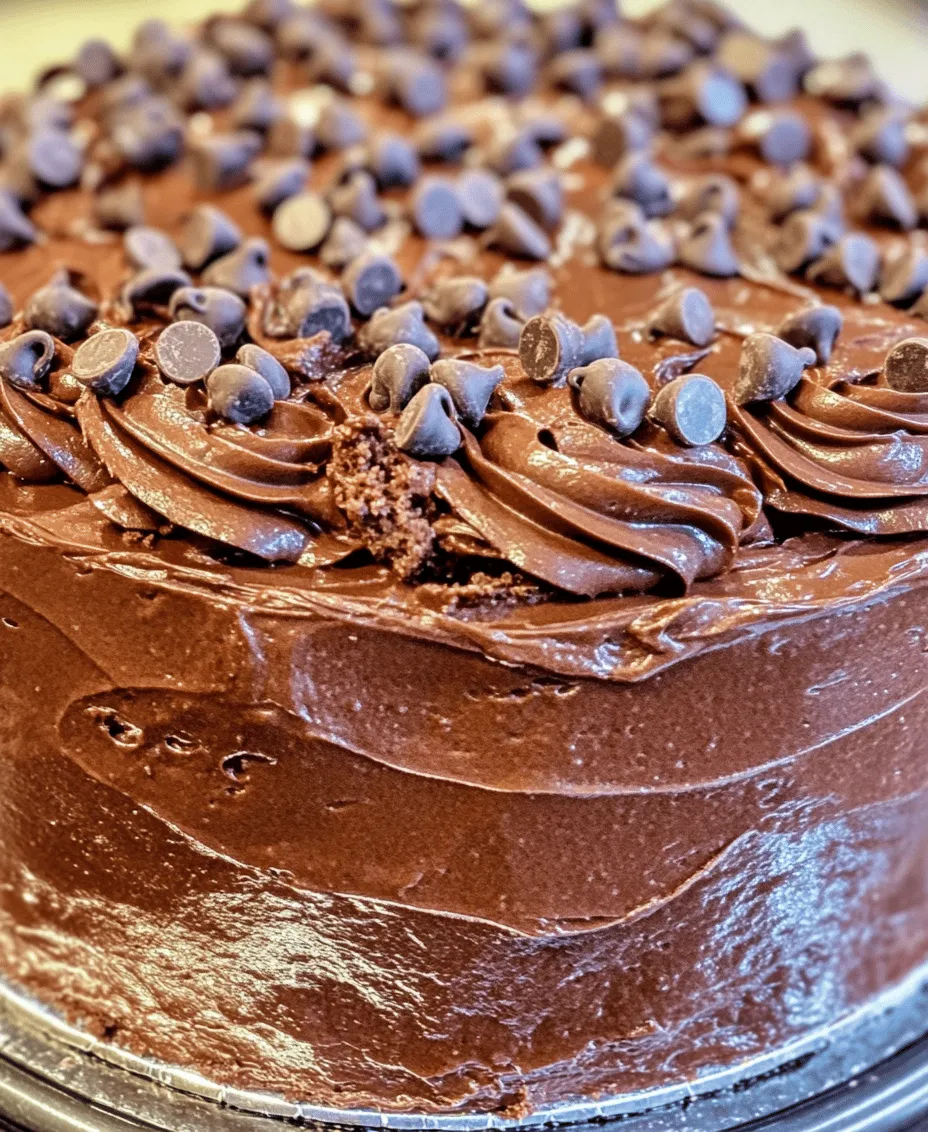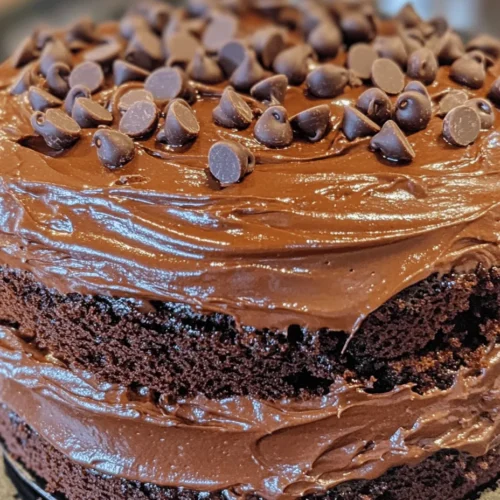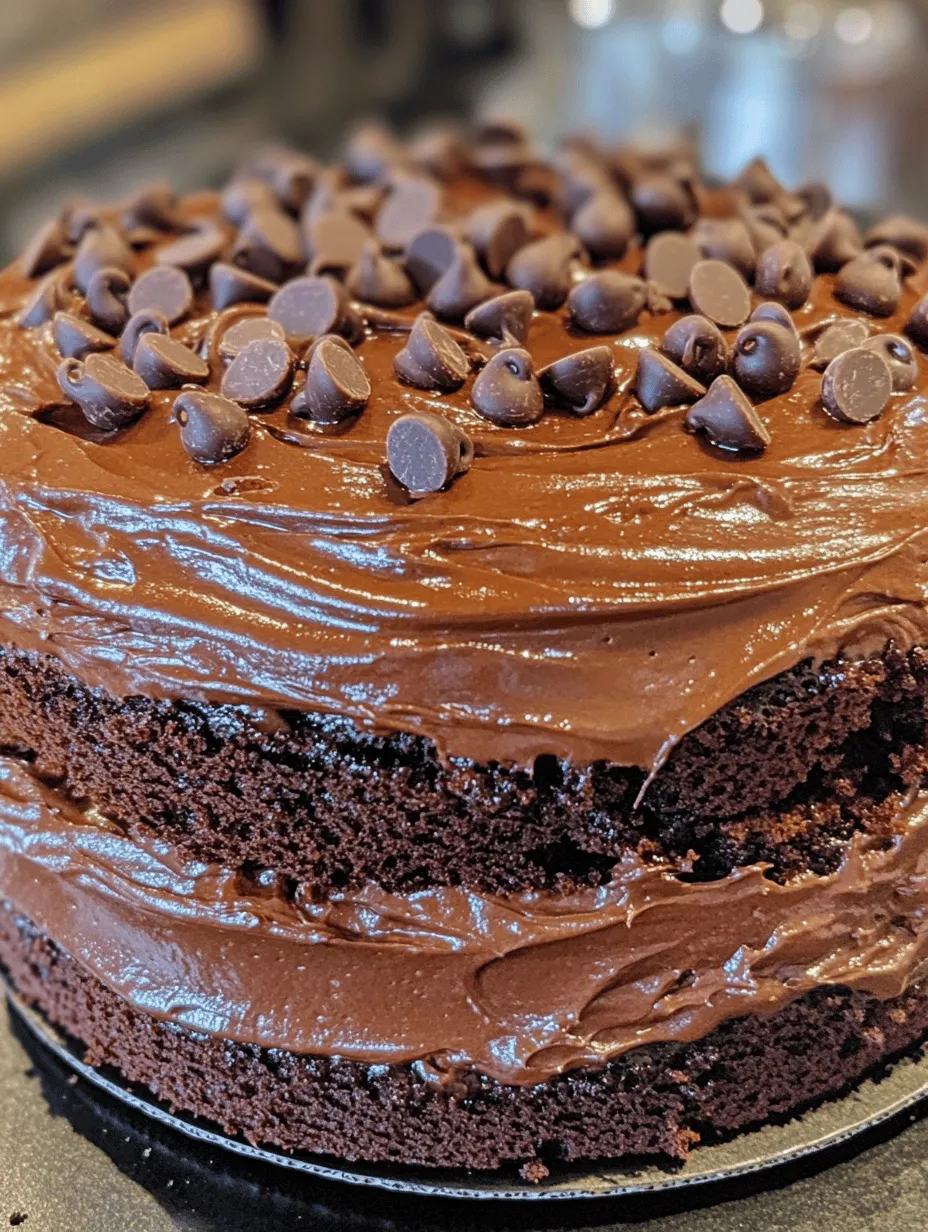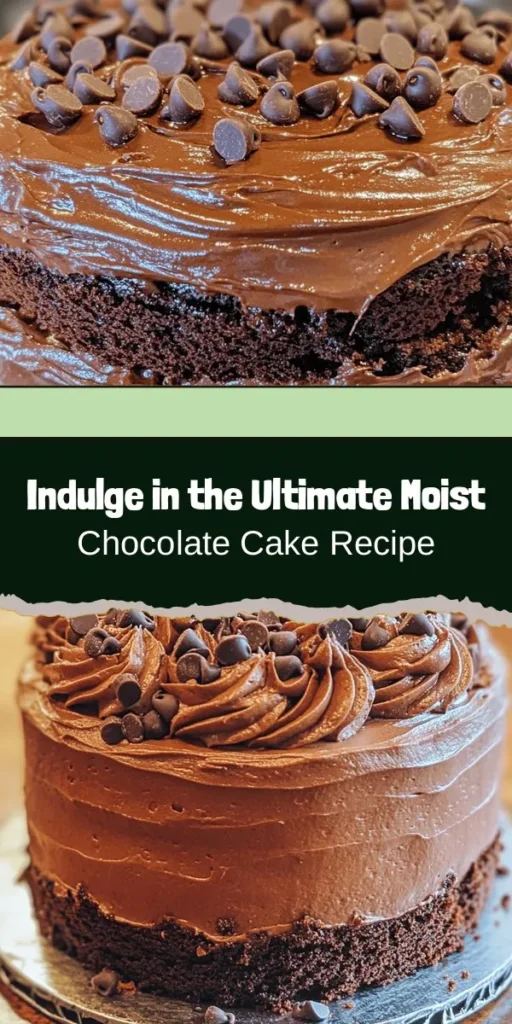Introduction to Decadent Delight: Moist Chocolate Cake
Welcome to the rich and indulgent world of chocolate! If you’re searching for a cake that not only satisfies your sweet tooth but also impresses with its moist texture and deep chocolate flavor, look no further than our Moist Chocolate Cake recipe. This delightful dessert is perfect for any occasion—be it a birthday celebration, a festive gathering, or a simple indulgence after a long day. The allure of a decadent chocolate cake lies in its ability to bring joy and comfort, making it a favorite among both bakers and dessert lovers alike.
The secret to achieving the perfect chocolate cake is rooted in understanding the ingredients, mastering the preparation process, and embracing a few baking techniques that ensure success every time. In this article, we will guide you through each step, from gathering the essential ingredients to the intricacies of mixing and baking. With the right approach, you’ll create a dessert that is as delicious as it is visually appealing, leaving your friends and family in awe.
Understanding the Ingredients
Overview of Key Ingredients
To create a Moist Chocolate Cake, it’s crucial to understand the role of each ingredient in the recipe. The right balance of components contributes significantly to the cake’s flavor, texture, and overall quality. Here’s a closer look at the key players in this decadent dessert:
Flour: The Foundation of the Cake
All-purpose flour serves as the backbone of the cake, providing structure and stability. The protein content in the flour develops gluten when mixed, which is essential for giving the cake its form while allowing it to rise. For the best results, ensure you measure your flour accurately, either by weighing it or using the spoon-and-level method. Too much flour can lead to a dry cake, while too little can result in a cake that collapses.
Sugar: Sweetening and Moisture Retention
Granulated sugar not only sweetens the cake but also plays a vital role in moisture retention. When sugar is creamed with eggs or fat, it helps to incorporate air, creating a light and fluffy texture. Additionally, sugar attracts moisture, ensuring your cake remains moist even days after baking. For an added depth of flavor, consider using brown sugar, which contains molasses and enhances the overall richness.
Cocoa Powder: The Heart of the Chocolate Flavor
Cocoa powder is the star of this chocolate cake. It provides the intense chocolate flavor that chocolate lovers crave. Always opt for high-quality unsweetened cocoa powder, as it greatly impacts the taste of your cake. For a richer profile, you can experiment with Dutch-processed cocoa, which is treated to neutralize acidity and yields a smoother, darker chocolate flavor.
Baking Powder and Baking Soda: The Leavening Agents
These two leavening agents are essential for achieving a light and airy cake. Baking powder contains both an acid and a base, allowing it to produce carbon dioxide gas when mixed with wet ingredients. Baking soda, on the other hand, requires an acid (like vinegar or buttermilk) to activate it. In this recipe, their combined action helps the cake rise beautifully during baking, creating a tender crumb.
Eggs: Binding and Moisture
Eggs serve multiple purposes in this cake. They bind the ingredients together, contribute to the cake’s structure, and add moisture. The proteins in eggs coagulate during baking, helping to set the cake’s form. For an extra fluffy texture, consider using room temperature eggs, as they incorporate more easily into the batter.
Milk: Enhancing Richness
Milk adds richness to the cake, contributing to its moistness and flavor. Whole milk is preferred, but you can substitute it with buttermilk for a tangy twist and extra tenderness. The liquid also helps to dissolve the sugar and cocoa powder, ensuring a smooth batter.
Vegetable Oil: Adding Moisture and Tenderness
Using vegetable oil instead of butter in this recipe enhances the cake’s moisture and tenderness. Oil remains liquid at room temperature, keeping the cake moist for longer. It also allows for a finer crumb, making each bite melt in your mouth. Feel free to use other neutral oils, such as canola or sunflower, for similar results.
Vanilla Extract: Elevating the Flavor
Vanilla extract is a classic flavor enhancer that rounds out the cake’s taste. It adds a subtle sweetness and aromatic quality that complements the chocolate. For a more intense flavor, consider using pure vanilla extract rather than imitation vanilla.
Boiling Water: Activating Cocoa and Creating a Thin Batter
One of the unique aspects of this recipe is the inclusion of boiling water. When added to the dry ingredients, boiling water helps to bloom the cocoa powder, intensifying its flavor and creating a smoother batter. This technique also results in a thinner batter, which aids in creating a moist and tender cake.
Optional Chocolate Chips: Extra Indulgence
For those who can’t resist an extra dose of chocolate, consider adding chocolate chips to the batter. Semi-sweet or dark chocolate chips can create delightful pockets of melted chocolate throughout the cake, enhancing its richness and providing a luxurious finish.
Preparation Process Breakdown
Prepping Your Kitchen for Cake Success
Before diving into the baking process, it’s essential to prepare your kitchen. Gather all your ingredients and tools, including mixing bowls, measuring cups, a whisk or electric mixer, spatula, and your cake pans. A well-organized kitchen will streamline the process and ensure you don’t miss any steps.
Importance of Preheating the Oven
Preheating the oven is a crucial step in baking. It ensures that your cake cooks evenly and rises properly from the moment it enters the oven. Set your oven to 350°F (175°C) and allow it to preheat for at least 15-20 minutes before placing your cake pans inside.
Greasing and Flourishing Cake Pans
To prevent your cake from sticking to the pans, it’s vital to grease and flour them properly. Use butter or cooking spray to coat the bottom and sides of the pans, then dust with flour. This step will help your cake release easily after baking, maintaining its shape and preventing any messy breakage.
Mixing the Dry Ingredients
In a separate bowl, combine your dry ingredients: flour, sugar, cocoa powder, baking powder, baking soda, and salt. Whisk them together until evenly mixed. This step is essential for ensuring that the leavening agents and flavors are evenly distributed throughout the batter.
The Importance of Sifting
Sifting your dry ingredients can make a significant difference in the final texture of your cake. Sifting breaks up any clumps in the flour and cocoa powder, aerating the mixture and helping to achieve a lighter cake. If you don’t have a sifter, you can use a fine-mesh sieve or simply whisk the dry ingredients vigorously.
Achieving the Right Consistency
When combined, your dry ingredients should have a fine, powdery consistency. This ensures that your batter will mix smoothly without lumps. If you notice any clumps, use a whisk to break them up before proceeding.
Incorporating Wet Ingredients
In another bowl, combine your wet ingredients: eggs, milk, vegetable oil, and vanilla extract. Mix them together until well-blended. When incorporating the wet ingredients into the dry mixture, do so gradually to maintain the structure of the batter.
Mixing Techniques for a Smooth Batter
When combining wet and dry ingredients, it’s essential to mix just until combined. Overmixing can lead to a dense cake due to excessive gluten development. Use a spatula or wooden spoon to gently fold the ingredients together, ensuring no dry flour remains. A few lumps are acceptable; the batter will smooth out during baking.
The Role of Boiling Water in Cake Texture
Once your batter is well-mixed, it’s time to add the boiling water. Carefully pour it into the batter, stirring gently until fully incorporated. The boiling water will thin the batter, allowing it to bake evenly and enhancing the cake’s overall moisture. This unique step is what sets this chocolate cake apart, ensuring an indulgent texture that is hard to resist.
Dividing and Baking the Batter
Next, divide the batter evenly between your prepared cake pans. Use a scale for precision if you want to ensure both layers are the same size, or simply eyeball it if you’re comfortable. Gently tap the pans on the counter to release any air bubbles trapped in the batter.
Importance of Even Distribution in Pans
Having an even distribution of batter in your pans is crucial for uniform baking. If one layer is thicker than the other, it may result in uneven baking, leading to a cake that is either undercooked or overcooked in certain areas. Ensuring both layers are the same size will yield a perfectly leveled cake that is easy to frost and serve.
With these preparation steps complete, you are well on your way to creating a rich and indulgent Moist Chocolate Cake that will leave a lasting impression on your taste buds. Stay tuned for the next part of this article, where we’ll delve into the baking process and share tips for achieving the perfect chocolate cake every time.

Baking Time and Testing for Doneness
Once your decadent chocolate cake batter is ready, it’s time for the most exciting part: baking! Preheat your oven to 350°F (175°C) and pour the batter into your prepared cake pans. Bake for approximately 30 to 35 minutes. However, oven temperatures can vary, so it’s crucial to test for doneness. Insert a toothpick or a cake tester into the center of the cake. If it comes out clean or with a few moist crumbs attached, your cake is done. If it still has wet batter on it, give it a few more minutes in the oven, checking every 2 to 3 minutes until it’s perfectly baked.
Cooling and Frosting the Cake
Cooling Techniques for Perfect Texture
Cooling your cake properly is just as essential as baking it. Once your cake layers are out of the oven, let them rest in the pans for about 10 to 15 minutes. This resting period allows the cake to firm up slightly and makes it easier to remove from the pans. After this, carefully turn the cakes out onto a wire rack.
Why Cooling is Essential
Cooling is crucial for achieving the right texture. A hot cake can become gummy if frosted immediately, as the heat causes the frosting to melt. Moreover, a properly cooled cake holds its shape better, ensuring that each slice is perfect and maintains its structure.
Transferring Cakes to Wire Racks
To transfer your cakes to wire racks, gently run a knife around the edges of the pan to loosen them. Place a wire rack on top of the pan, invert it, and gently tap to release the cake. Repeat this process for all layers. Allow the cakes to cool completely, which can take about 1 to 2 hours.
Choosing the Right Frosting
When it comes to frosting your moist chocolate cake, the options are plentiful. The right frosting can elevate your cake from delicious to divine. Consider whether you want a rich chocolate ganache, a creamy buttercream, or even a light whipped cream frosting. Each option brings a different texture and flavor profile that can complement the chocolate cake beautifully.
Popular Chocolate Frosting Options
1. Chocolate Buttercream: A classic choice, chocolate buttercream is rich and creamy, making it a popular option for layered cakes. To make it, beat softened butter with cocoa powder and powdered sugar, adding a splash of milk until you reach your desired consistency.
2. Chocolate Ganache: For a more decadent option, chocolate ganache is unsurpassed. Simply heat equal parts heavy cream and chocolate together until melted and smooth. Pour it over the cake for a glossy finish, or let it cool and whip it for a fluffy frosting.
3. Whipped Cream Frosting: If you prefer something lighter, whipped cream frosting is a refreshing choice. Whip heavy cream with sugar and vanilla until soft peaks form, then spread it generously over your cake.
Tips for Frosting a Layered Cake
– Chill Your Layers: After cooling, place your cake layers in the refrigerator for about 30 minutes. This helps to firm them up and makes frosting easier.
– Use a Crumb Coat: Before applying your final layer of frosting, spread a thin layer of frosting (the crumb coat) on the cake to seal in crumbs. Chill again for about 20 minutes before applying the final coat.
– Smooth Finish: Use a bench scraper or offset spatula to create a smooth finish on your frosted cake.
Decorating Ideas for Presentation
Presentation is key when it comes to cakes. A beautifully decorated cake can be as delicious to look at as it is to eat. Here are some ideas:
– Simple and Elegant Decoration Techniques: Use a piping bag fitted with a star tip to create decorative swirls on top. You can also sprinkle cocoa powder or powdered sugar for a touch of elegance.
– Adding Personal Touches with Toppings: Consider adding toppings such as chocolate shavings, fresh berries, or edible flowers. These not only enhance the appearance but also add textures and flavors that complement the chocolate cake.
The Science Behind a Moist Chocolate Cake
Understanding the science behind a moist chocolate cake can help you master the art of baking.
The Role of Each Ingredient in Achieving Moisture
– Flour: The type of flour you use affects the texture. Cake flour is lower in protein than all-purpose flour and results in a more tender cake.
– Sugar: Sugar not only sweetens but also attracts moisture, helping to keep your cake moist.
– Fat: Ingredients like butter or oil contribute to the richness and moisture. Oil, in particular, tends to create a softer texture due to its liquid form.
How Sugar Affects Texture
Sugar affects more than just sweetness; it plays a critical role in creating a tender crumb. During the creaming process, sugar helps to aerate the batter, which is essential for leavening. The sugar crystals create tiny air pockets that expand during baking, contributing to a light and fluffy cake.
The Impact of Baking Time on Moisture Retention
Baking time is crucial for moisture retention. Overbaking can lead to a dry cake, while underbaking can result in a dense texture. The goal is to find that sweet spot where the cake is fully cooked but still retains its moisture.
Understanding Cake Chemistry
Cake baking is essentially a chemical reaction. When you combine the right ingredients and bake them at the correct temperature, you create a delicious dessert. The balance of flour, sugar, fat, and leavening agents causes your cake to rise and develop its structure.
The Science of Leavening Agents
Leavening agents like baking powder and baking soda create gas bubbles in the batter, causing it to rise. It’s important to use the right amount—too much can lead to a cake that collapses, while too little will result in a dense texture.
The Importance of Temperature in Baking
Temperature affects not only the baking time but also the way ingredients interact. For example, using room-temperature eggs and butter helps to create a smoother batter and better emulsion, leading to a more consistent texture throughout the cake.
Serving Suggestions and Pairings
Ideal Occasions for Moist Chocolate Cake
Your moist chocolate cake is versatile and perfect for a variety of occasions:
– Birthdays, Anniversaries, and Celebrations: A chocolate cake is a classic choice for celebrations, bringing joy to any gathering.
– Casual Family Gatherings and Potlucks: Easy to transport and share, this cake can be a hit at family dinners or potluck events.
Beverage Pairings to Enhance the Experience
Pairing your chocolate cake with the right beverage can enhance the overall experience. Here are some suggestions:
– Coffee: The bitter notes of coffee complement the sweetness of chocolate beautifully.
– Milk: A classic choice, milk balances the richness of the cake.
– Dessert Wines: Pair with a sweet dessert wine such as Port or a chocolate-infused liqueur for a sophisticated touch.
Conclusion: The Joy of Baking and Enjoying Chocolate Cake
In conclusion, this moist chocolate cake recipe is not just a dessert; it is an experience that brings joy and satisfaction to both the baker and the consumers. Understanding the ingredients and the science behind them empowers you to create a cake that is not only delicious but also a testament to your baking skills. Whether enjoyed plain, frosted, or adorned with toppings, this cake is sure to be a cherished addition to your recipe collection, inviting sweet memories with each slice. Embrace the joy of baking, share it with loved ones, and savor the delightful moments that a slice of homemade chocolate cake can bring.



